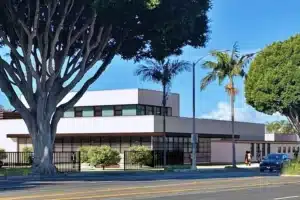Arizona Republic USA TODAY NETWORK
Saturday morning was emotional for LaVerne Jackson, who had tears in her eyes as she walked along a newly paved sidewalk toward a brand new school on the Gila River Indian Reservation.
On her walk, she passed bus stops and crossed a bridge — things that she said are simple, yet incredibly significant.
Jackson, a member of the tribe, recalled growing up in the area and often going to the old Gila Crossing Community School during its recreation hours for lunch.
The school was considered old even when Jackson was young, and it hadn’t been revamped in the decades since.
She remembered seeing rodent feces in the old trailer stuffed with dusty, outdated books that served as a library.
“It broke my heart,” she said. “No wonder our education is in the spot that it’s in and people choose to go off (the reservation).”
Jackson also attended school off the reservation, but has grandchildren who attended the old facility and will now be taught at the new and improved Gila Crossing Community School.
For that, Jackson said she’s extremely grateful.
“It’s just incredible, all the technology that’s in each room,” she said. “It’s scary to me because I grew up without it, but it’s a push forward.
“They’ll be able to succeed in whatever it is, it’s right at their fingertips.”
“It’s not just the Rez anymore — they have access to the whole, wide world.”
‘We’re going to continue as a people’
The K-8 school’s innovation was mentioned by nearly all of the speakers, which included Gila River Indian Community Gov. Stephen Roe Lewis, Assistant Secretary for Indian Affairs Tara Sweeney and Rep. Greg Stanton during a nearly two-hour program Saturday morning.
The school, at 4665 W. Pecos Road in Laveen, has advanced technology and myriad ways to accommodate students of different abilities.
Approximately one-third of the chairs in the school’s elementary classrooms are wobble chairs, a flexible seating option meant to help students who are fidgety or need extra sensory stim-
All teachers will have microphones that will stream the sound through several speakers on the ceiling, so all students can easily hear the teacher regardless of where they’re seated.
A special education classroom also features a 10 foot-by-10 foot sensory room with subdued colors, carpet instead of tile and soundproof walls in an effort to accommodate students who are overstimulated.
But innovation and modernization to the school doesn’t imply an erasure of tradition.
Project planners made sure to emphasize the tribe’s culture every step of the way, a mentality that’s evident throughout the school.
The layout of an outdoor pavilion area is meant to symbolize a flowing river, for example, and the security gates were designed to look like the traditional Ocotillo fences that are common within the tribe.
All of the artwork and designs throughout the school were crafted by members of the community or students at the previous facility, with many of the works depicting plants and animals native to the area.
Signage throughout the campus also features phrases in the tribe’s tongue next to their English translation.
“Nyyuum ‘iiwa xotk!,” which means “I am glad to see you!,” and “Sap Eth Tha:k Em Ñei!,” which means “It makes me feel good to see you!” are two of the phrases in the school’s outdoor area.
During a tour of the campus, Jackson asked whether a home economics class would be teaching students how to prepare traditional foods.
To her delight, a school official said that they would be.
“It gives me hope that we’re going to continue as a people,” she said. “We’re not going to fade, we’re not going to die out — we’re not going to let that happen.”
‘If we can build a casino, why can’t we build a place for our children to learn?’
In an interview with The Arizona Republic Saturday morning, Lewis said the tribe was “making history” with the opening of the school.
The project utilized a financing method that’s never been done in Indian Country before.
The community self-financed the school’s construction and then struck a leasing arrangement with the Department of Interior and the Bureau of Indian Education to get repaid.
Though it took a lot of money, hours and energy to make the project come to fruition, Lewis said it was worth it because of the competitive edge it’ll give the approximately 500 students expected to attend the school.
“They are our future and investing in a school like this ensures that they’re going to get every advantage possible,” he said.
Lewis said he hopes the school serves as a model of how to improve infrastructure across Indian Country, adding that officials are already looking into other potential schools and facilities on the reservation they can renovate in a similar fashion.
That would be a dream come true for Jackson, who said she hopes education is a priority for all tribes moving forward.
“If we can build a casino, why can’t we build a place for our children to learn?” she said. “If we can build this casino for a year, why are our children attending a condemned school?”
Tribal leaders implied that Gila Crossing Community School is just the first step in improving infrastructure on the reservation, but for Jackson, it was a huge one.
“If I die tonight, I’ll be dying happy,” she said.
TynanGroup partnered with Rider Levett Bucknall and Johnson Construction Management as the Project Managers on this innovative project.



